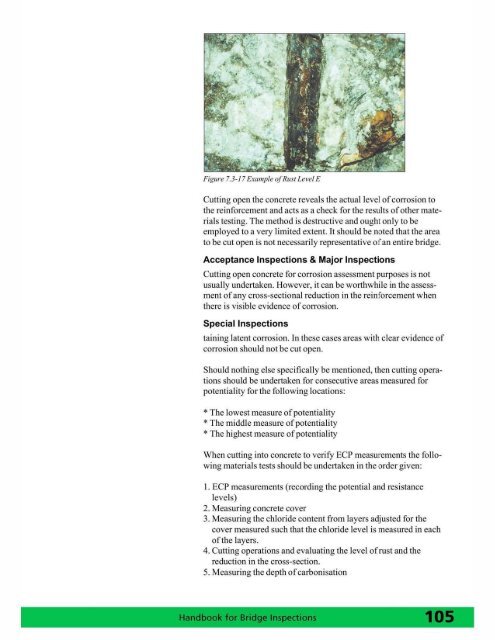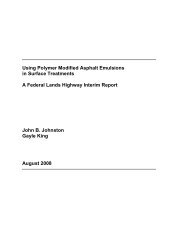Handbook for Bridge Inspections - TSP2
Handbook for Bridge Inspections - TSP2
Handbook for Bridge Inspections - TSP2
You also want an ePaper? Increase the reach of your titles
YUMPU automatically turns print PDFs into web optimized ePapers that Google loves.
Figure 7.3-17 E.wmpleQJRlIsl Level £<br />
Cutting open the concrete reveals the actual level of corrosion to<br />
the rein<strong>for</strong>cement and acts as a check <strong>for</strong> the resu lts of other materials<br />
testing. The method is destructive and ought only to be<br />
employed to a very limited ex tent. It shoul d be noted that the area<br />
to be cut open is not necessarily representative of an entire bridge.<br />
Acceptance <strong>Inspections</strong> & Major <strong>Inspections</strong><br />
Cutting open concrete fo r corrosion assessment purposes is not<br />
usually undertaken. However, it can be worthwhi le in the assessment<br />
of any cross-secti onal reduction in the rein<strong>for</strong>cement when<br />
there is visible evidence of corrosion.<br />
Special <strong>Inspections</strong><br />
tain ing latent corrosion. In these cases areas with cl ear evidence of<br />
corrosion should not be cut open.<br />
Should noth ing else specifica lly be mentioned, then cutting operations<br />
should be undertaken <strong>for</strong> consecutive areas measured <strong>for</strong><br />
potentiality <strong>for</strong> the following locations:<br />
* The lowest measure of potentiality<br />
* The middle measure of potentiality<br />
* The highest measure of potentiality<br />
When cutting into concrete to veri fy ECP measurements the fo llowing<br />
materials tests should be undertaken in the order given:<br />
I. ECP measurements (recording the potential and resistance<br />
levels)<br />
2. Measuring concrete cover<br />
3. Measurin g the ch loride content from layers adj usted <strong>for</strong> the<br />
cover measured such that the chloride level is measured in each<br />
or the layers.<br />
4. Cutting operati ons and evaluating the level o f rust and the<br />
reduct ion in the cross-section.<br />
5. Measuring the depth of ca rbonisation
















